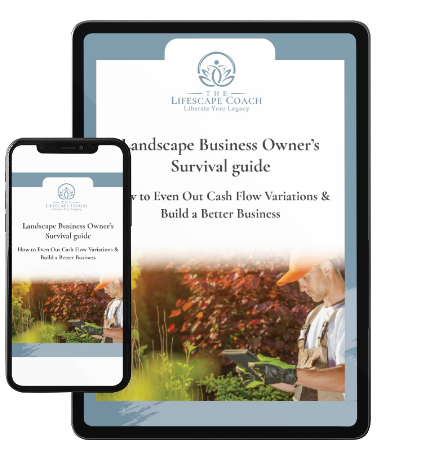5 crucial actions when you start a successful landscape business
One of the easiest things to do once you’ve started a landscape business is to dive right into the immediate projects at hand and plug away at every job that comes your way. It’s also one of the least productive things you can do, in the long run.
Wait, how can getting jobs done not be productive?
Because getting jobs done is not Job Number One, which is building your business – and you do that by working on business development from day one. Of course, that does NOT mean you shouldn’t be concerned about selling and completing projects on a timely basis – that’s vital for keeping your clients happy and creating positive cash flow. What it does mean is that you also need to carve out time to actively work on the business aspects of your fledgling company – new business development, payroll, accounts payable and receivable, and so on.
If you don’t focus immediately – and stay focused – on building your business, you won’t have one for long. At least not a successful one. You may bump along for years, struggling from job to job, trying to keep up with paying bills and paying yourself sporadically and never enough. But that’s no way to run a business. That’s just surviving - making ends meet - not thriving.
Free download: The Landscape Business Owner's Survival Guide - This guide offers valuable insights into how to establish and grow a landscape business.
The trick is to balance what I call “clean hands work” and “dirty hands work.” Dirty hands work, as you might imagine, is getting your hands dirty working directly on landscaping projects. Clean hands work is the things you do back in the office – whether that’s real commercial space or your kitchen counter -- to build your business. If you decide, from the very beginning, to allocate 20 percent of your time to clean hands work, you’re well on your way to building a successful landscape business.

Here are five tips to help you make the most of that 20 percent:
1. Focus on your finances. That means learning how to manage your money well. Choose a good bank that will work closely with you in good times and bad. Understand the difference between a cash flow statement and a P&L statement – they tell a different story and help you gain a better understanding of your business’s financial standing at any given time. Establish a working relationship with a good accountant to help you stay on top of all your bookkeeping. I highly recommend some bookkeeping software that you set up smartly from day one, so that printing financial reports is super easy.
2. Pay yourself first. This is absolutely key to creating a happy, healthy career and business. Figure out what you need to earn and make sure you pay yourself that first. Small business owners sometimes do not pay themselves enough – or at all -- robbing Peter to pay Paul so they can meet other expenses without meeting their own. Been there, done that. It’s no fun! If your business cannot pay you, then it is not a business. Make sure the money you need to live, money you need to spend, and money you need to save is taken into consideration. You need all three.
3. Document your vision with an organizational chart. We’ve previously discussed the need to have a vision for your company’s future - a goal and a roadmap. Now that you have started the business, you need to solidify that vision by creating a living, breathing organizational chart. Don’t worry, it doesn’t have to be carved in stone. Consider it a “living document” that will need to change as your business changes. It’s important to remember that your organization will evolve as you learn what works for you and as you evolve as a businessperson.
 It takes time to understand the help you need as you grow your business. Remind yourself that you started your business because you are fully capable -- you’re a competent multitasker and can juggle balls with the best of them. But even the best juggler will falter depending on how many balls they’re trying to keep in the air. If you believe you can quickly create an organizational chart and think it‘s done, chances are good you will fail.
It takes time to understand the help you need as you grow your business. Remind yourself that you started your business because you are fully capable -- you’re a competent multitasker and can juggle balls with the best of them. But even the best juggler will falter depending on how many balls they’re trying to keep in the air. If you believe you can quickly create an organizational chart and think it‘s done, chances are good you will fail.
As tennis great Arthur Ashe used to say, “Start where you are. Use what you have. Do what you can.” Outline what you consider an optimal organization at this time – the people and resources you need to get things done, get paid, and grow your company. But be open to revision and evolution. And be ready to hand over tasks to people in your organization as it grows. The org chart will help you manage work you do versus work done by others.
4. Stand for something. The landscape industry is vast and wide. It is critical in the early years to determine what you stand for in the industry and how you will operate as an owner and employer. This will be your backbone as a business, as a leader, and as an industry professional. It is easy to be a generalist with no defined purpose and direction.
True satisfaction comes from having a well-defined purpose and direction. Having a direction and purpose helps you build the right team. You won’t know this right away when you start the business, so write down and evaluate what makes you feel good about jobs, clients, experiences, and what doesn’t. Shift your focus to those projects, people, and activities that fulfill you and away from those that don’t.
5. Surround yourself with the right people. They are the ones who believe in you and support you, as well as those individuals who inspire you and who you aspire to be. This collective is your “tribe.” This is the group that will have your back and help you grow.
Don’t confuse your tribe with family and friends or the broader group of tradespeople you associate with on a regular basis. While they can certainly be part of your support network, it’s not a given that they will or even can be a part of your tribe. Remember, striking it out on your own, as the founder of a business, can be both risky and scary. Often the people that love you the most don’t have your drive or ambition, they just want you safe. And while you may find great trade buddies, they may not be rooting for your success in the way you need. SO...what does tribe mean?
Your tribe is a core group of people that understand what you’re trying to achieve, believe in you, and are willing to both go to bat for you and hold you up when the going gets tough. They come in all forms - people you pay like an employee, a business coach, or marketing guru, well-aligned professionals from associations of all kinds, select clients, personal accountability partners, and even sometimes people you don’t know - authors, speakers, educators. You tap into this group regularly to feed your inspirations and aspirations along the not so straight and narrow road of entrepreneurship.
A little knowledge goes a long way.
I have been in the landscape business for over three decades and, truth be told, I knew none of this when I started out. I discovered these little nuggets of wisdom only recently. Because of this, I had a number of false starts in my career and periods when I felt isolated and ill-equipped to succeed.
Fortunately, I stuck to it and essentially earned my own degree in entrepreneurship, self-taught - on top of that one I paid for many years ago in college. As a result, I have had more success, gained more recognition, and built more brand value in the past ten years than I could have dreamed of in the first twenty. If only I had discovered and embraced these five key points years ago!
I hope you will put these five tips to work for your company and build good business habits early on. They will help you have a greater, more positive impact on your community and your team – and that will translate into greater success and satisfaction for you!
Image Copyright: 123RF Stock PhotoLandscape Business Owners Survival Guide



